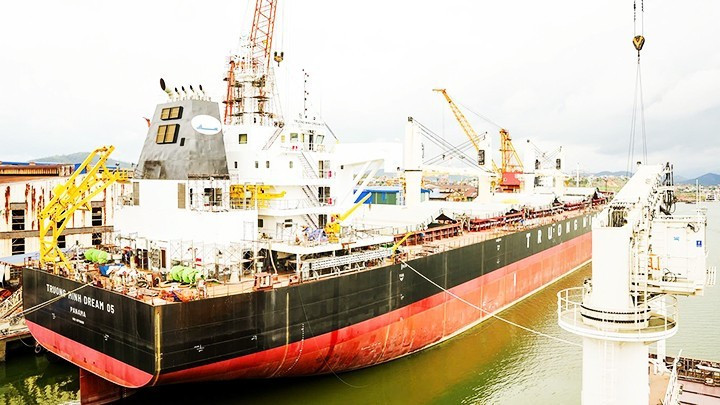Viet Nam’s shipbuilding industry sets sail once more
Once a symbol of the nation's industrialisation aspirations, Viet Nam's shipbuilding industry was not only a source of national pride as the country set its course for the open seas, it also held a strategic role in developing the maritime economy and safeguarding sovereignty.

Amid numerous challenges, determined shipbuilders continue to work tirelessly in factories in Quang Ninh, Hai Phong, Ho Chi Minh City, and beyond, helping to position Viet Nam as the seventh-largest shipbuilding nation in the world. With market value forecasts of up to 680 million USD by 2032, the key question is: what path will the Shipbuilding Industry Corporation (SBIC) — a corporation that is simultaneously undergoing bankruptcy procedures while shouldering the responsibility of revival — take to lead the industry back onto the global maritime map?
During its golden age, Vinashin employed as many as 70,000 workers, with factories running at full capacity and export orders shipping out across five continents. But then came the wave of restructuring, sweeping away past glories. Amid this upheaval, the most skilled and passionate workers chose to remain, clinging to hope for the industry's revival.
Behind every maritime achievement
At dawn in the Pha Rung Shipbuilding Company in Hai Phong, the clatter of grinders and the clang of steel blend into a symphony of industrial life. Nguyen Van Trinh, Head of Welding Team No. 2, who has worked since 1998, said that from this very factory, his entire family has followed in his footsteps: his wife operates cranes, his son is a design engineer, and his daughter-in-law is an intern in the technical department — a true “shipbuilding family”. Viet Nam’s shipbuilding industry began with humble workshops by rivers and coastal areas, rudimentary platforms, and the calloused hands of workers like them.
A turning point came after 1996, when Vinashin (now SBIC) was established, ushering in a period of rapid growth. Between 1996 and 2008, over 400 vessels were launched, many of which were exported to Europe and the Middle East. The Financial Times dubbed Viet Nam “a rising star in medium-sized shipbuilding in the East”. However, during the 2009–2014 restructuring phase, the industry was struck by an undertow. Trinh recalled: “At the peak, we ran triple shifts and only took days off for Tet. Each ship launch was a celebration, with locals flocking to witness the event with pride. But by 2010, the yard was practically shut down, with steel scattered everywhere. Skilled workers left one by one. I had to sell my motorbike; my monthly salary barely covered five days’ work. But I stayed because I wanted to preserve the craft.”
In the face of hardship, resilient workers stayed. Luong Thi Hang, a senior welder at Pha Rung, shared: “For three months we had no orders and delayed wages. Everyone was discouraged. I considered leaving but remembered all those years with the trade and decided to stay. From welding, I learned to operate CNC cutting machines. It’s tough, but I refused to give up.” Thanks to such workers, Pha Rung slowly began to recover.
Pham Thanh Ngoc Hoang, a worker at Bach Dang Shipbuilding Company, offers another modest yet inspiring story of resilience. Starting as a manual labourer, he studied while working to earn his engineering degree, eventually becoming a team leader and deputy head of the workshop’s trade . He persevered during the industry’s most difficult years (2008–2015), learning and gaining experience. His commitment paid off when the company sent him abroad for training, where he accessed advanced technologies before returning to transfer those skills to his fellow workers. “It was the older generations who stayed on through every challenge that instilled in me a special determination to stick with this profession,” Hoang said.
At Ha Long Shipbuilding Company, engineer Pham Thu Hang, born in 1982, has dedicated 21 years to the ship electrical system workshop. Responsible for completing the electrical systems, the “lifeblood” of each vessel, she has worked in extreme conditions: scaling 200-metre-high masts and squeezing into the tight confines of a ship’s hull. She continually updates her knowledge to master cutting-edge technology on modern vessels. “Coming from a family deeply rooted in shipbuilding, growing up in the shipyard, and now working here, all of this gives me strength to overcome difficulties. For me, happiness is working alongside my colleagues, overcoming adversity, and seeing our ships sail into the open seas,” Hang reflected.

An invaluable asset
In 2009, Vinashin employed as many as 70,000 workers, including seasonal labourers. However, the restructuring storm swept through, dissolving and merging numerous firms. Factories that once had over 10,000 workers were reduced to mere hundreds, with some shutting down entirely. Yet amidst this brutal filtering process, the most skilled and dedicated remained. They became the pillars that kept the industry from collapsing, breathing life into the cold steel with their enduring commitment.
At Pha Rung Shipyard, the workforce dropped from 2,755 in 2011 to just 650 skilled technicians and workers, who were sent to Japan and the Republic of Korea to learn advanced technology and professional practices. Project manager and engineer Vu Manh Ha, who began as an entry-level assembly worker and later trained both domestically and abroad, understands the value of craftsmanship: “Keeping the workers means preserving the soul of the factory. A good worker must not only know their trade but also be creative, proactive, and capable of adapting in a volatile global environment,” he stressed.
At shipyards such as Song Cam, Nam Trieu, Bach Dang, and Ha Long, the image of welders drenched in sweat has gradually been replaced by technicians in air-conditioned cabins operating plasma and CNC steel-cutting machines with near-perfect precision. This shift exemplifies the remarkable transformation of Vietnamese workers. However, their self-driven efforts alone are not enough. For ships to truly “sail into the open sea”, visionary leadership is essential — leadership that dares to invest in people for the long term. Nguyen Ba Son, Deputy Director of Bach Dang Shipbuilding Company, noted: “Workers are at the heart of restructuring. Streamlining the organisation effectively means improving workforce quality, not only skills but also technological proficiency and language ability.” Bach Dang is one of the few firms to boldly send workers abroad to work and study simultaneously, fostering innovation and aligning with international standards. Many return to become key figures in transferring new technologies to the factory floor.
Discussing the restructuring process and streamlining operations, Dam Quang Trung, Party Secretary and Chairman of Song Cam Shipbuilding Company, emphasised: “The number one principle is retaining talent to boost efficiency.” According to him, despite reducing its workforce, Song Cam has enhanced productivity and quality thanks to three pillars: maintaining a core team of skilled workers and engineers, increasing automation in standardised stages, and building a network of supporting enterprises while retaining only the most technically demanding stages in-house. A distinctive aspect of their corporate culture is the “reverse training” model, in which veteran engineers directly mentor younger workers in “mini technical teams” responsible for the full quality of each product. Through regular team meetings, professional expertise and responsibilities are passed down from one generation to the next. “We don’t lack orders, we lack workers ready to perform. Training high-tech workers is no easy task. The state should adopt specific policies, such as vocational schools linked to enterprises, subsidised tuition, guaranteed employment, and tax incentives for firms accepting trainees,” Trung proposed.
Lessons from Song Cam, Nam Trieu, Pha Rung, Bach Dang, and Ha Long show that maintaining a bloated apparatus is unnecessary. The shipbuilding industry can recover through streamlined, modern thinking, effective collaboration, and a people-centred development strategy. However, a serious challenge remains: the average age of shipyard workers is now over 40, and young people are reluctant to enter the trade due to its physically demanding nature and unstable income. Vocational schools for shipbuilding are becoming increasingly empty. Without a comprehensive national-level policy solution, Viet Nam’s shipbuilding industry will struggle to maintain the internal strength needed to break through in an increasingly fierce global competition.








